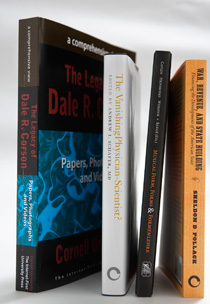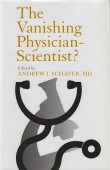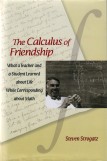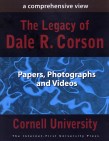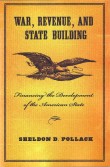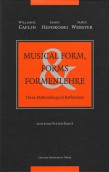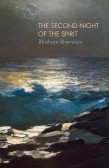CORNELL BOOKS
Musings on physicians, friendship, an ex-president's legacy and family tragedies
Physician-scientist, heal thyself
"The Vanishing Physician-Scientist?" (Cornell University Press, 2009) looks at the vital -- and now threatened -- role that physicians have played in medical discovery.
Physician-scientists devote the majority of their research lives to the quest for understanding about health and disease, often basing their scientific questions on the experience of caring for patients. Physician-scientists also communicate between researchers in the "pure sciences" and practicing health care providers. Yet there is a growing concern that physician-scientists will ultimately vanish from the scene.
In this book, edited by Dr. Andrew I. Schafer, the E. Hugh Luckey Distinguished Professor and Chair of the Department of Medicine at Weill Cornell Medical College, leading physician-scientists examine their role from historical, demographic, scientific, cultural, sociological and economic perspectives. Their recommendations, along with those of academic physicians, if heeded, could help preserve and revitalize the community of physician-scientists as the profession continues to evolve and boundaries between doctors and researchers shift.
Schafer is also physician-in-chief at NewYork-Presbyterian Hospital/Weill Cornell Medical Center. The book, published under CUP's ILR Press imprint, is part of the Culture and Politics of Health Care Work series, co-edited by Suzanne Gordon, a Cornell alum (and a CUP author).
'A shining star of generosity and humility'
The best teachers are not always the ones that we learn the most from in class, or the ones we choose initially or consciously to be our mentors. Sometimes, they are simply individuals who love the thing we love, or who guide us by example.
"The Calculus of Friendship" (Princeton University Press, 2009) is Cornell mathematician Steve Strogatz's story about his high school calculus teacher Don Joffray and their intersection over 35 years.
For most of those years, the two corresponded sporadically, in ebbs and flows. "A lot has happened to us over the last 30 years," Strogatz said at a September reading of his book. "But in our letters to each other we don't talk about those things. We just do math problems."
It was enough -- until an offhand comment by his wife, Carole, made him wonder.
He went back to see Joffray and discovered that while his own math expertise had long surpassed his teacher's, he continued to learn from the man he calls "a shining star of generosity and humility."
"Joff is brave about change … the changes that calculus can tame, and the ones it cannot. He confronts them all, and not … with his mind alone but also with his heart," he writes.
Strogatz discussed his book with actor Alan Alda in September at Manhattan's 92nd Street Y.
Legacy of a singular scientist-leader
Dale R. Corson served Cornell as professor and chair of the Department of Physics, dean of the College of Engineering, provost of the university and, from 1969 to 1977, as its eighth president -- weathering Vietnam War protests and the aftermath of the Willard Straight takeover while building the university's position as one of the great research institutions. He was the second president of Cornell to be drawn from its faculty.
His varied career included discovering a missing element in the periodic table and wartime development of new radar techniques. Later he joined the staff of Los Alamos Scientific Laboratory. After coming to Cornell in 1946, he helped design the university's first synchrotron. In retirement he created the unusually accurate sundial displayed on the Engineering Quad and helped to found the Kendal at Ithaca retirement community.
All that and more can be found in "The Legacy of Dale R. Corson" (The Internet-First University Press, 2009), produced by J. Robert Cooke, professor emeritus of biological and environmental engineering and former dean of the university faculty. After a short biographical sketch by Corson about his early years, the book documents his Cornell career with lectures, letters, documents and many photos. An accompanying DVD includes photos and videos.
The book and Web-quality versions of the videos can be viewed online at ecommons.library.cornell.edu/handle/1813/3613. For printed copies or the DVD, e-mail digital@cornell.edu or call 607-255-2524.
How the USA grew itself
War, revenue and institutional development are linked throughout American history, says Sheldon D. Pollack (Ph.D., government, 1980) in "War, Revenue, and State Building: Financing the Development of the American State" (CUP, 2009). Pollack looks at how the United States went from a British colony to a developed economy in under a century by using a very effective system of public finance.
The book traces the sources of public revenue available to the American government at specific periods in its history (particularly during times of war), the revenue strategies pursued by its political leaders in response to these factors and the consequential impact of those strategies on the development of the American state.
Debate, in print, on musical form
In "Musical Form, Forms & Formenlehre: Three Methodological Reflections" (Leuven University Press, 2009), three eminent music theorists discuss how to analyze form in music and question the relevance of analytical theories and methods in general. James Webster, the Goldwin Smith Professor of Music, and his two co-authors illustrate basic concepts and their concerns by offering concrete analyses of works by Mozart and Beethoven.
The volume is in the form of a debate, with each of the three parts beginning with a basic essay by one of the authors followed by commentary on issues the other authors consider to be problematic or underdeveloped, in a style that ranges from the gently critical to the overtly polemical. The author of the essay then replies and further refines his own fundamental ideas on musical form.
The volume is edited by Pieter Bergé. CUP distributes books by Leuven, a Belgian academic publisher, in North America.
Making sense of an illness and a death
Two family tragedies fuel a debut collection of poems, "The Second Night of the Spirit" (CavanKerry Press, 2009), by Bhisham Bherwani '92.
Childhood encephalitis left his older brother with a severe mental handicap; years later his father's unexpected death left a gaping emptiness in the carefully calibrated family dynamic.
Bherwani chronicles his brother's illness and how he and family members cope with the unforgiving reality. In the poem that shares the book's title, he imagines an attempt to enter his brother's damaged brain, urging Asclepius, the Greek god of healing, to visit, heal, bless and weep. "Hemlock and Hellebore" honors his father's unsettling death with references to poisons.
The world Bherwani creates "is a deeply moving place to be," writes Chard deNiord in the foreword, "a real place as well as an internal stage on which a powerful family drama is played out in originally conceived, highly personal poems that make universal connections."
